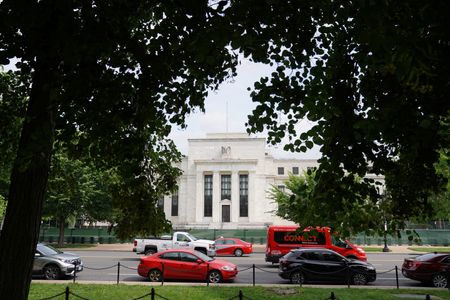By Howard Schneider
WASHINGTON (Reuters) – The outlook from U.S. Federal Reserve officials at their meeting this week sees interest rate cuts beginning next year, relief, it would seem, from the ratcheting up of borrowing costs that has been underway since the spring of 2022 and left consumers and businesses grousing about their mortgages and bank deals.
But coupled with the anticipated path of inflation, those projections actually indicate monetary policy will grow more restrictive through 2024 on a “real” or inflation-adjusted basis. That means financial conditions may not become as freewheeling as the headline rate numbers suggest.
It’s a nuance undergirding why the Fed sees inflation continuing to fall through next year and unemployment rise despite expected lower interest rates.
Fed Chair Jerome Powell nodded to it in his Wednesday press conference when he was asked why policymakers would reduce borrowing costs in 2024 even with inflation still above the Fed’s 2% target.
His answer: We’re not. At least not really.
What projections show “is that as inflation comes down in the forecast, if you don’t lower interest rates, then real rates are actually going up,” he said.
And in fact, that seems to be what many on the Fed intend: A real policy rate of interest that gradually tightens next year even as the “nominal” rate printed in its policy statement declines. It’s an indication of policymakers’ determination not to give inflation a chance to rekindle as they pressure it back toward their 2% objective.
For U.S. consumers, it could play out this way: Mortgage and credit card rates come down at the margin, but not by as much as inflation.
REAL VS NOMINAL
Under the median projections provided this week, monetary policy actually grows slightly more restrictive next year.
By the end of 2023, the gap between the expected federal funds rate and the expected rate of core personal consumption expenditures inflation is 1.7%.
By the end of 2024 that spread actually widens to 2%, as the interest rate declines but the rate of inflation falls more sharply.
It’s an example of how the world occupied by central bankers – where the distinction between “real” inflation-adjusted variables, and “nominal,” or in-name-only numbers, is vital – differs from the world where consumers live and eat and buy their homes, where falling rates are falling rates.
The financial system is the bridge between the two, and for banks, mortgage companies and bond funds, estimating the path of inflation and adjusting investments and the price of loans to account for it can make the difference between record profits and bankruptcy – as the failure of Silicon Valley Bank demonstrated.
In fact the Fed is counting on its small, subtle tweak to “financial conditions” to keep monetary policy restrictive through next year as part of its effort to cool demand and spending and, through that, to lower inflation.
It’s a subtle exercise that plays on psychology and behavior as much as anything. With consumer bank savings rates now above 4%, for example, above the most recent level of annual consumer price inflation, an old-fashioned bank account is now an effective inflation hedge. Any dollar kept there is a dollar kept out of the spending spree the Fed is trying to curb.
Just as Fed efforts to stimulate the economy are meant to influence businesses and households to bring consumption forward in time – spending today instead of tomorrow – the aim now is to push consumption back by making it more costly to borrow and more rewarding to save.
It’s not something the Fed intends to stop soon.
Under the most recent projections, the real federal funds rate doesn’t decline until the end of 2025, and even then remains above the central bank’s current estimate of “neutral,” meaning it is still high enough to put the brakes on the economy.
(Reporting by Howard Schneider; Editing by Dan Burns and Andrea Ricci)





